Located on the South coast of England, Brighton & Hove Albion FC, affectionately nicknamed as “The Seagulls,” has evolved into one of the most fascinating clubs in English football. Established in 1901, the club started in a humble league, the Southern League, and nowadays, it is a club that faces the giants of England on an equal footing in the Premier League.
What sets Brighton apart is not just its rise through the ranks and tables of English football but all the community with their supporters and fans that show the passion for the club. From the Goldstone Ground (their first stadium) to the amazing Amex Stadium, every step of the Seagulls is filled with passion and hope. Their history is proof that with hard work, everything is possible.
So, come with me to learn about Brighton & Hove Albion FC. In this article, we’ll discover the club’s history, uncover key moments, show some iconic players that fans love, and unforgettable matches. Whether you’re a supporter and a fan or simply intrigued by the magic of football, the history of Brighton is one that deserves to be told.
Early Days: Formation and Struggles (1901-1920s)
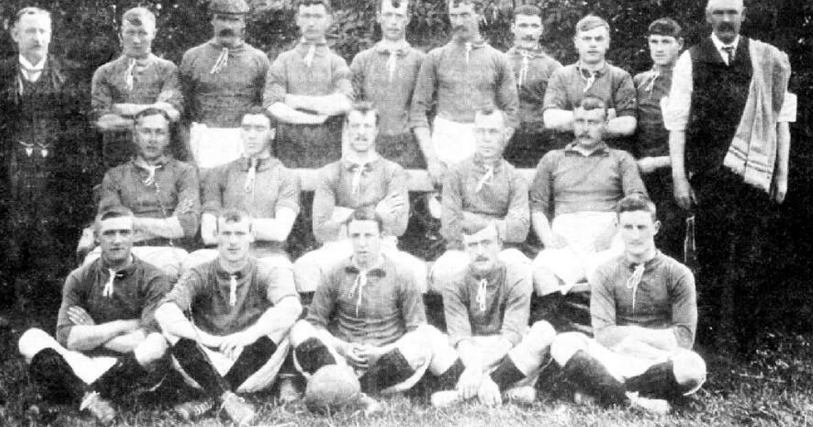
The origins of Brighton & Hove Albion FC can be traced back to 1901, when the club was formed to provide a sporting opportunity for the growing seaside town of Brighton. Originally known as Brighton & Hove Rangers, the team later adopted the new name, Brighton & Hove Albion FC, to reach the broader area and its aspirations for inclusivity. This decision helped establish a strong local identity, bringing the club closer to the community. Brighton and Hove are as if they were two cities united in the same territory, as if it were a district.
The Seagulls began their football journey in the Southern League, known today as Football League Two, or the Third Division in England. The Southern League was considered a competitive and prestigious league during the early 20th century.
The club initially played at the Hove County Ground, a humble venue that served as their initial home ground. However, only a few games happened in the Hove County Cricket Ground, because the club, in 1902, was relocated to the Goldstone Ground, which would become an iconic part of their history. The Goldstone Ground was demolished in 1997.
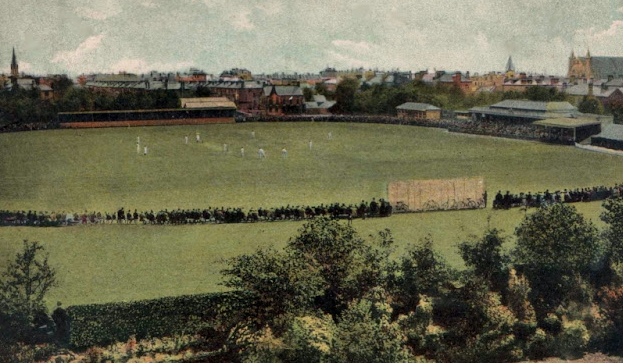
The early years of Brighton were marked by financial instability and limited resources, something that was common for clubs that were starting to develop. Despite some struggles, the Seagulls managed to make history, and the club won the FA Charity Shield in 1910.
The club emerged victorious in the final against Aston Villa 1-0, a historic victory as Aston Villa was the Football League champion that year. It provided hope and demonstrated that the club’s potential could be much bigger than they thought.
World War I destroyed football at that time, and like many clubs in Europe, Brighton faced challenges in resuming its actions after the war.
Post-War Era
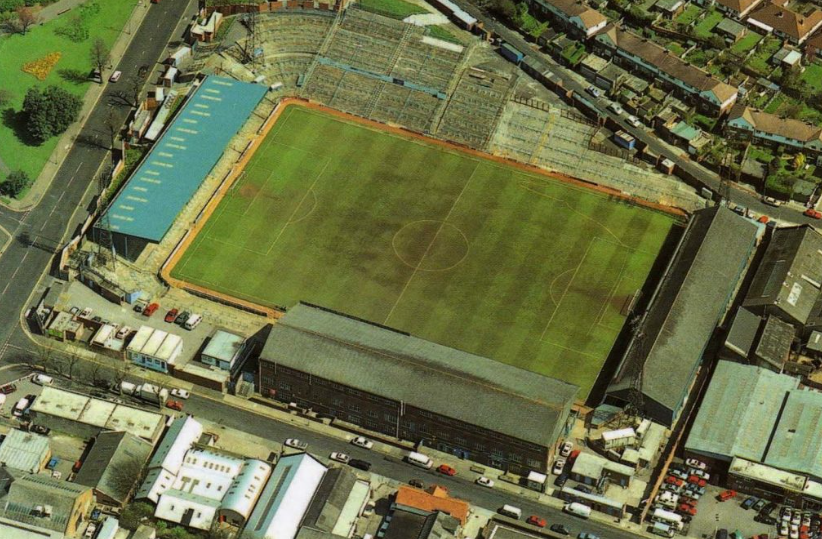
The post-war years saw the club fighting to adapt to the new reality of football, including the rise of professionalism and the expansion of the Football League.
All these problems and challenges were important to help the club eventually enter league football, even if the club’s journey continued with some difficulties, including poor performances and financial problems.
Through these formative years, Brighton established a loyal fanbase of supporters and fans, since its modest achievements. The sense of community and passion for football and the club was seen as important to the club’s identity in the city, starting a story of many achievements that were to come.
Climbing the Ranks: From Southern League to Football League
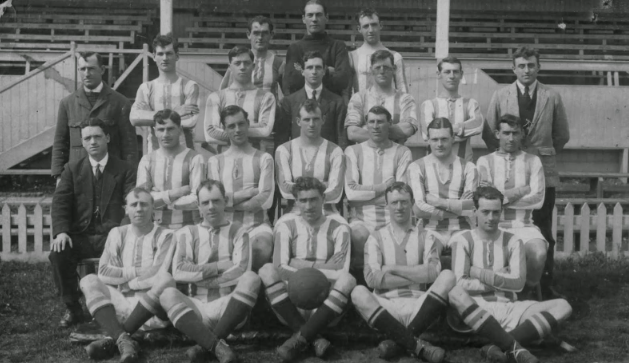
The 1920s were crucial for Brighton and Hove Albion, as the club changed from regional football in the Southern League to national competition in the Football League. In 1920, Brighton became one of the founding members of the Football League Third Division, which was an important moment because it increased the club’s status in English football.
Brighton has started competing with other teams that dreamed of success. The club’s inclusion in the Football League marked the start of a new chapter filled with challenges and opportunities.
Goldstone Ground
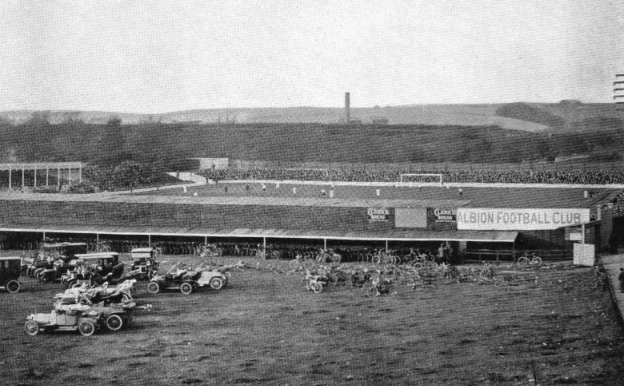
The Goldstone Ground was an iconic venue, but needed some improvements to accommodate the growing demands of league football. Despite these obstacles, Brighton fought to improve their ground where the club played games and built their reputation as a hardworking team.
During this stabilization period, the club focused on survival and slow progress. Notable players began to appear, such as Tommy Cook, an English player who became the all-time leading scorer in the 1920s and 1930s a few years later. The player was important to keeping the team competitive. Cook, in addition to being a soccer player, had a career as a cricket player, a famous sport in the country at that time.
The 1930s and 1940s saw Brighton continue to fight to rise in the football hierarchy, but a new challenge arrived: World War II once again destroyed football across the country. The war years were very challenging for the Seagulls, as the club, like many others, faced financial difficulties and the loss of key players to military service.
Football, like many other sports, began to hold regional championships to keep the clubs in order, even if they didn’t reach the standards of the national leagues. These championships were important, making the clubs not failures at the time.
Rebuilding of Brighton
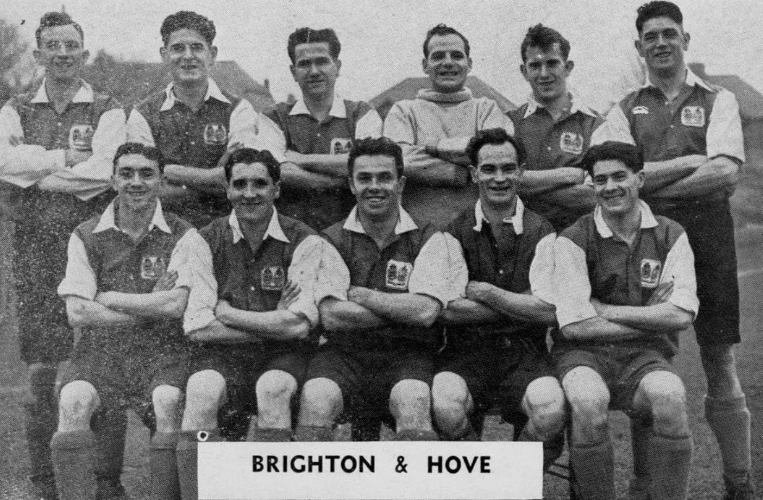
After the war, Brighton and Hove Albion entered a period of rebuilding. The post-war era saw the club looking for new talents and renewed energy. This moment was important to establish itself as a new and consistent team in the Football League.
In the 1950s, Brighton cultivated a devoted fanbase, with the Goldstone Ground consistently packed with passionate supporters. The club was determined to elevate its performance on the pitch, and their efforts paid off. Although they had yet to secure promotion to the higher divisions, their steady progress laid the foundation for future success, setting the stage for even greater achievements.
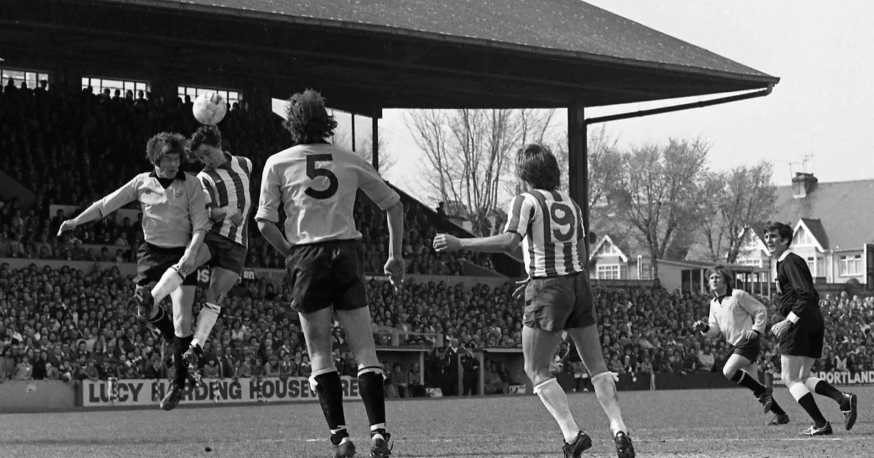
One characteristic of this era was the connection between the club and its fans and supporters. Despite limited success, the community helped sustain the Seagulls through difficult times. At the time, Brighton & Hove Albion became a symbol of local pride in the city.
This period was important for establishing the rivalries between Brighton and other clubs and some traditions that shaped the club’s identity, like the team joining the Second Division in 1958 after a 6-0 victory against Watford.
Although the club had limited success in terms of trophies, it steadily climbed through the divisions. Step by step, Brighton earned promotions, paving the way for a remarkable rise in the decades to come.
1970s: Promotions of Brighton & Hove Albion Football Club to the Top Flight
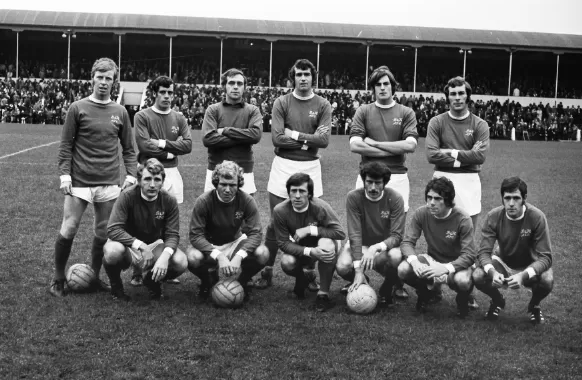
Mike Bamber was the president of the club in 1972 until 1983. The 1970s were a transformative decade for the club. The club left lower leagues and started new flights until reaching the elite of England football.
An important figure in this transformative period was Alan Mullery, who took over as manager in 1976. Mullery brought a fresh vision to the club, earning the trust of his squad and implementing a more dynamic, attacking style of play. Under his leadership, Brighton saw significant improvement on the pitch, though they did not secure any major titles during his tenure.
Key players emerged under Mullery’s leadership, with Peter Ward standing out as a pivotal figure. During the 1976/77 season, Ward played a crucial role, scoring an impressive 36 goals—setting a new club record and earning the Golden Boot.
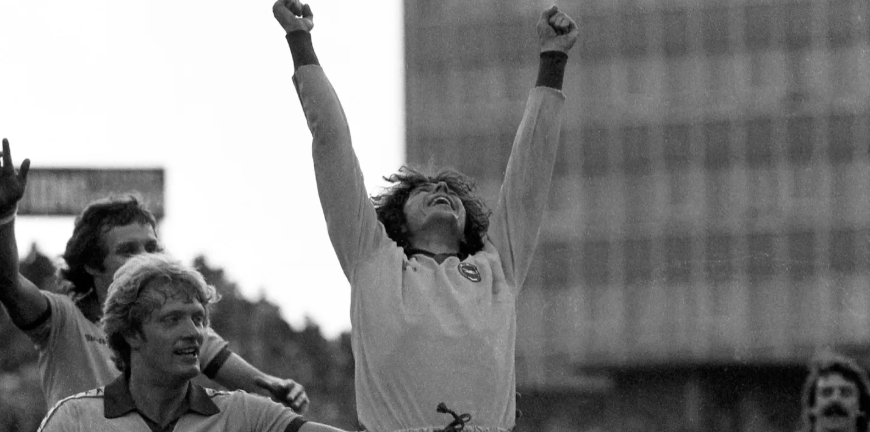
The journey of Brighton until the elite of football was tough. The competition in the Football League Second Division was complicated, with multiple teams competing between them for one dream: the league’s promotion.
The 1978/79 season proved to be a watershed moment for Brighton and its fans, as the club secured promotion to the First Division for the first time in its history. Under Mullery’s leadership, Brighton finished second in the league, just one point behind champions and fierce rivals Crystal Palace.
The Goldstone Ground became a fortress for the club in this period, hosting the games and supporting the team on game days. All fans and supporters were already euphoric to see the club participate in the best football championship in the country.
1980s: FA Cup Final and Financial Problems
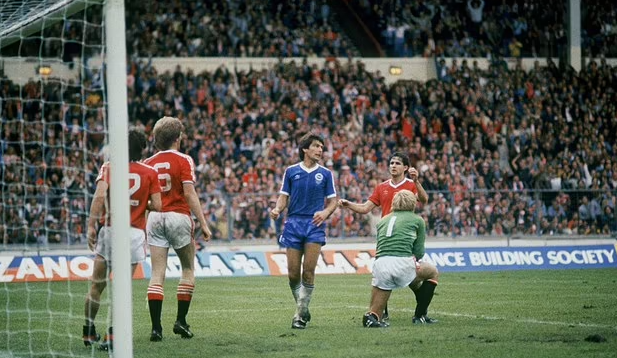
The 1980s were a decade of highs and lows for Brighton & Hove Albion, remembered as one of the most memorable moments in the club’s history. In 1983, Brighton achieved their first-ever FA Cup final appearance, a moment that remains in the minds of all fans.
Under Jimmy Melia’s guidance, the Seagulls surprised everyone and reached the final, defeating teams like Newcastle United and Manchester City along the way. Their campaign was unbelievable and enchanted football fans across the country, as a team from outside the elite showcased beautiful football and determination in one of the most prestigious competitions in England.
The final, held at Wembley Stadium on May 21, 1983, saw Brighton face off against Manchester United in a historic clash. However, the match turned into a nightmare for the Seagulls. As they edged closer to lifting the trophy, nerves seemed to take hold, impacting their performance against the formidable Red Devils.
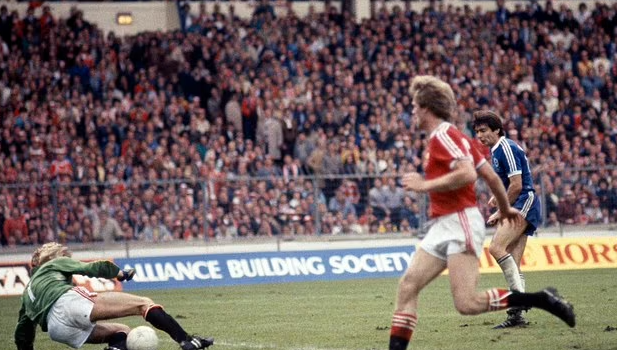
With the game tied at 2-2 in extra time, Brighton had a golden opportunity to secure victory when Gordon Smith found himself one-on-one with Manchester United’s goalkeeper. However, his shot was saved, and the match ended in a draw, forcing a replay.
The second game took place on May 26, 1983, but Brighton’s hopes were crushed as they suffered a 4-0 defeat. It marked the third consecutive year that the FA Cup final required a replay. Despite the heartbreak, the 1983 FA Cup final remains a cherished memory for Brighton fans, symbolizing the club’s ability to compete at the highest level and fueling hopes of future success.
Following the FA Cup final, the quality of appearances in the games began to decline. The Seagulls were relegated to the Second Division at the end of the 1982/83 season, starting a new era of troubles and difficulties for the club.
Some financial problems occurred, with rising debts messing with the club’s stability. The Goldstone Ground, once a symbol of the club’s pride, has become a constant danger for the club due to high maintenance and low attendance at the games due to the precarious infrastructure.
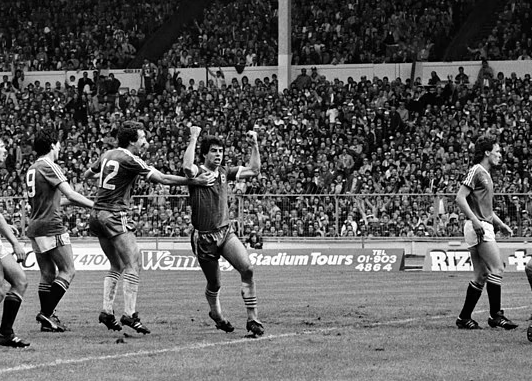
Despite these challenges, the 1980s showed the passion and commitment of fans to the club. Players like Steve Foster were iconic players and a symbol of Brighton’s courage. He gave his all in the club’s most difficult moments. Meanwhile, the fans and supporters remained firm in supporting the team, even with all the financial problems that the club was facing.
The decade ended with Brighton facing an uncertain future, even if the spirit and passion of the fans and supporters for the club remained unbroken. The 1980s were years of many ups and downs, but that would be marked in the club’s history since it achieved great success and needed everyone’s support to continue being a club so loved by its fans.
Fight for Survival: 1990s

The 1990s were one of the most turbulent and dangerous decades in the history of Brighton & Hovel Albion, with the club almost declaring bankruptcy. During this time, the club fought to survive, both on and off the pitch, once again, with financial instability and poor performances.
In 1995, the club’s stadium, the Goldstone Ground, was sold by the club’s owners to pay off some debts, a decision that scared all fans. The club became homeless and was forced to play its home games 70 miles away at Gillingham’s Priestfield Stadium for two seasons. The stadium is located in Gillingham, Kent, England.
This period highlighted the unwavering passion of Brighton’s fans, whose support proved crucial in the club’s survival. Through protests and campaigns, they fought to save their beloved team. This dedication led to the creation of the “Fans United” movement, which saw supporters from across the country—and even beyond—rally behind Brighton in a remarkable show of solidarity, making it a defining moment in world football.
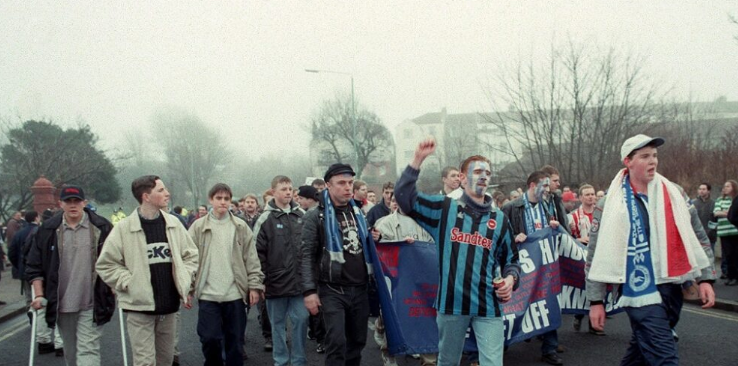
On the pitch, Brighton faced an even greater crisis. In the 1996/97 season, the club found itself on the brink of relegation to non-league football. To make matters worse, they were docked two points following a fan invasion during protests against the sale of the Goldstone Ground.
The season’s final match against Hereford United became a do-or-die battle for survival. With everything on the line, Robbie Reinelt emerged as the hero, scoring a crucial equalizer to secure a 1-1 draw. This result kept Brighton & Hove Albion in the Football League while condemning their opponents to relegation instead.
The 1990s ended with Brighton still fighting for stability but united by the love and dedication of their supporters and fans. In the week before the last Goldstone Ground, an agreement was made between Dick Knight and Bill Archer to control the club and try to maintain in order the club and the stadium.
However, the legal agreement was not finalized until September 1997, resulting in the demolition of the Goldstone Ground. With no home of their own, Brighton was forced to play the following season at Gillingham’s Priestfield Stadium, enduring yet another period of uncertainty.
New Era: Amex Stadium and Premier League Glory
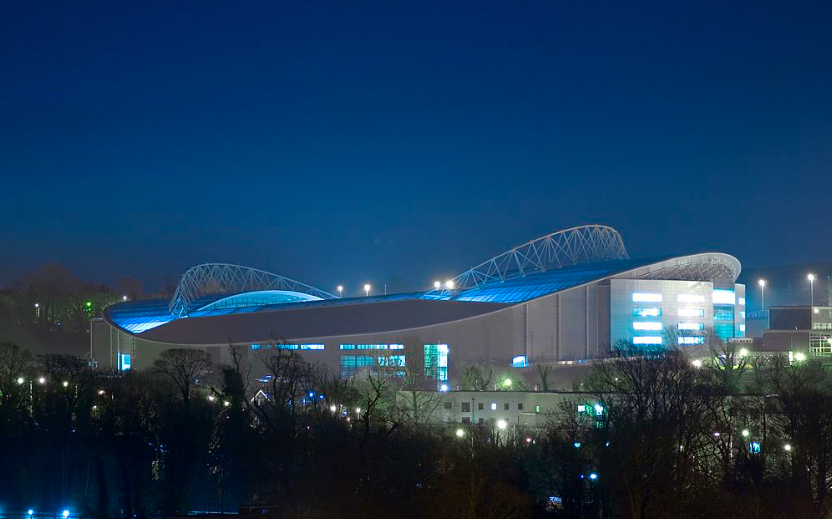
The turn of the millennium marked a new chapter for Brighton & Hove Albion. After decades of struggle and adversity, the club reached the Premier League and built the Amex Stadium, a symbol of their transformation. The stadium, opened on May 31, 2011, saw its first match at the end of the 2010/11 season, with Brighton facing Eastbourne Borough on July 16, 2011.
Following years of instability, the Seagulls began their resurgence, thanks to the investment and dedication of entrepreneur Tony Bloom. Under his guidance, the club evolved significantly, and the construction of the American Express Community Stadium (Amex) in Falmer ushered in a new era for Brighton.
After playing at the modest Withdean Stadium following the demolition of the Goldstone Ground, the move to the Amex Stadium provided Brighton with a state-of-the-art venue, capable of hosting their growing ambitions and solidifying their place among football’s elite.
New Renovations
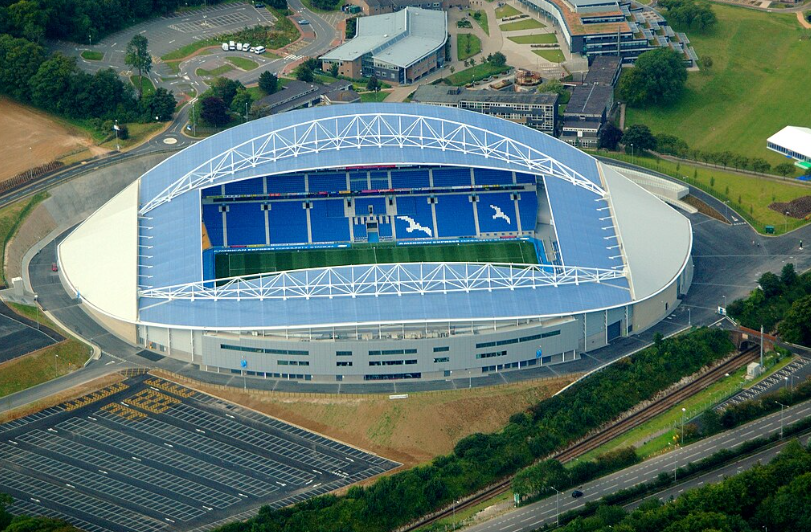
The new stadium, with its modern facilities and passionate atmosphere, had a capacity of almost 32,000 fans. It provided the perfect place for a team on the rise. In the spring of 2025, the club will open The Terrace, and in the next two seasons, the stadium will undergo new renovations to better accommodate its fans.
The Amex was built with a 22,500 capacity and expanded in 2013 to 30,750. After being promoted to the Premier League in 2017, the stadium underwent some updates and now has a capacity of 31,876.
Ascension with Coaches
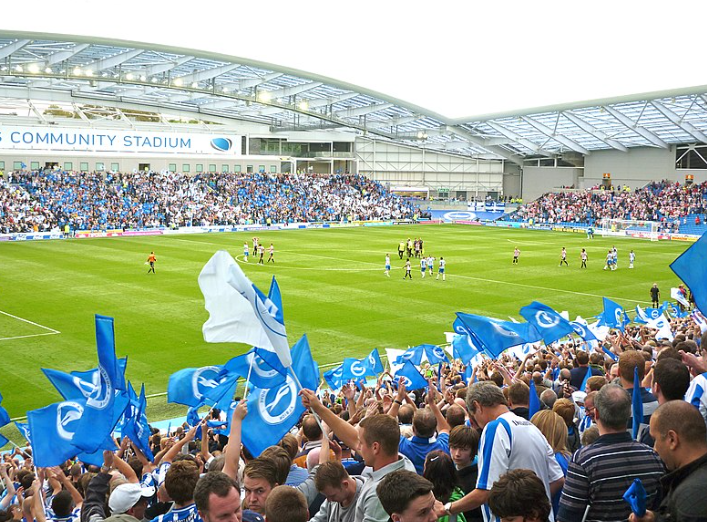
On the pitch, Brighton began their ascent under Chris Hughton, who led the club to the Premier League in the 2016/17 season after finishing second in the Championship.
After Hughton, Graham Potter took over and guided the club to new heights, with a well-drilled team that regularly challenged the Premier League’s Big Six. Potter’s success at Brighton caught the eye of Chelsea, who appointed him for the 2022/23 season. However, his tenure at Chelsea was not as successful, and after parting ways with the club, he took on the managerial role at West Ham United.
In 2024, Fabian Hürzeler, a former player and German football manager, became Brighton’s manager. Hürzeler aims to maintain the club’s consistency under its previous managers.
Iconic Players of Brighton & Hove Albion
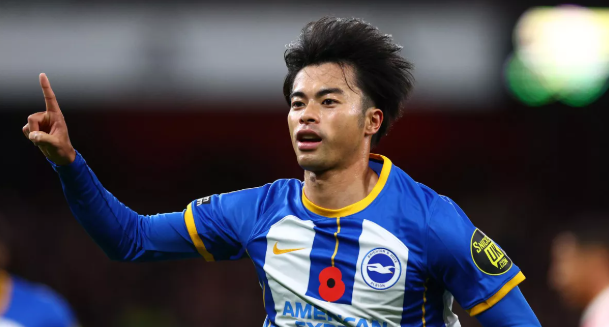
Throughout its history, Brighton & Hove Albion has been home to legendary players who have left their mark on the club. Now, I’ll introduce you to some of these players, and I’d love to know which ones you’re already familiar with!
Before we dive in, here’s an interesting tidbit: the player in the photo above, Mitoma, completed his university studies at Tsukuba University in Japan before pursuing a career in professional football.
Peter Ward
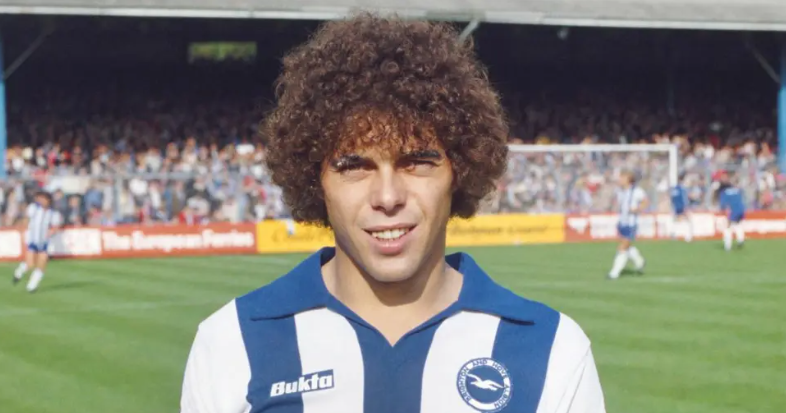
No name is more closely related to the beginning of Brighton’s golden era than Peter Ward. During his passage in the 1970s and 1980s, Ward participated in the first major promotion of the club to the First Division, now the Premier League.
In his debut season, Ward scored an impressive 26 goals in 38 appearances. The following season, 1976/77, he claimed the Golden Boot, netting 36 goals and breaking the club’s scoring record.
Ward was later loaned to Nottingham Forest, where he made 28 appearances, before spending time at the Seattle Sounders in the MLS. He returned to Brighton for the 1982/83 season.
Bobby Zamora
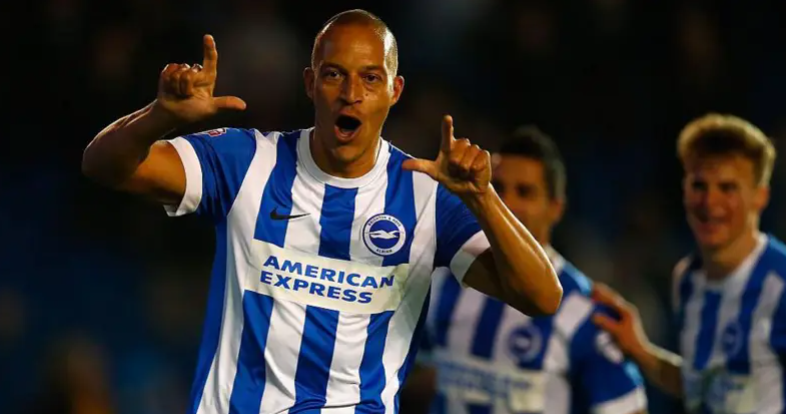
After a long period where Brighton struggled to reach the highest levels of English football, Bobby Zamora emerged as a key figure in the early 2000s. The player was in the Bristol Rovers, and after a successful loan, Zamora made a permanent move to Brighton.
With the club, Zamora helped Brighton win two successive championships, the Third Division (Level 4) and League One (Level 3), a division below the Championship.
Zamora scored over 80 goals in his two passages with Brighton, and he is an idol of the club.
Bruno Saltor
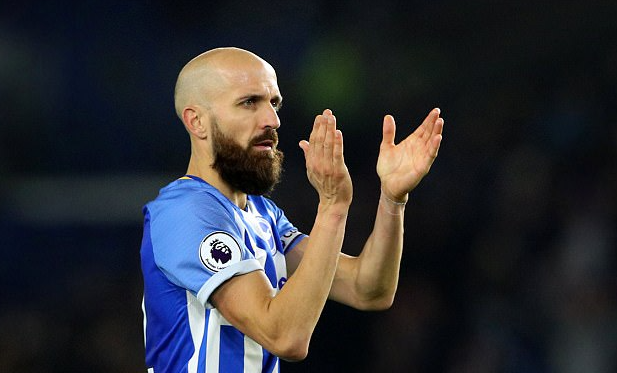
Bruno Saltor, the Spanish right-back, is another important player who helped Brighton establish itself in the Premier League. Arriving at the club in 2012 from Valencia CF, Bruno became captain and leader of the team on and off the pitch.
Bruno helped the club win promotion to the Premier League. He played the Championship with Brighton in the 2016/17 season, and after 34 years, the club reached the first division again, now known as the Premier League.
In 8 years with Brighton & Hove Albion, the Spanish player made over 200 appearances and scored six goals. While his goal tally may seem modest, his contribution to the club’s history is undeniable, and his impact on the team was significant.
Lewis Dunk
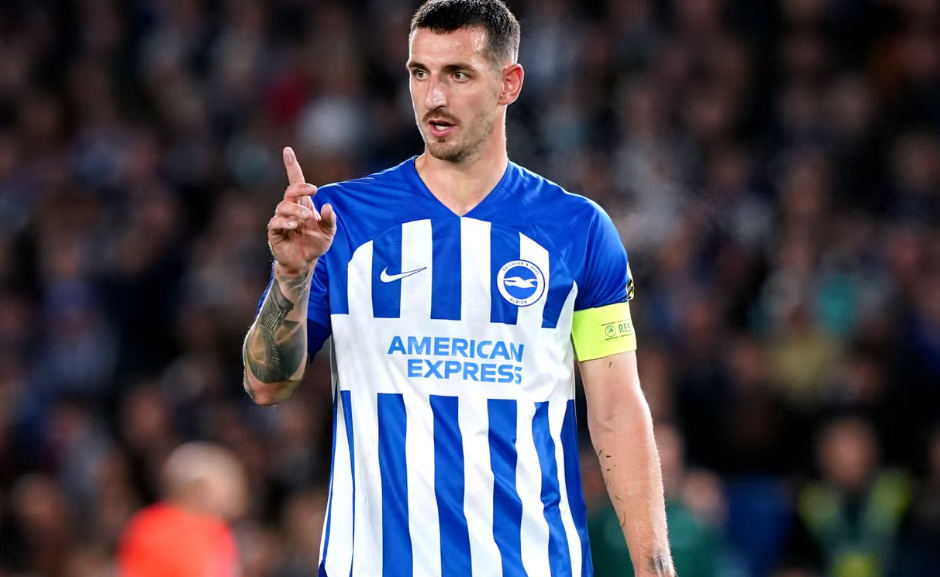
Lewis Dunk, a product of Brighton’s youth academy, has been instrumental in the club’s recent success. The English defender has spent his entire career at Brighton, with the exception of two brief loan spells at Bognor Regis City and Bristol City, where he played a combined total of 10 games.
A true club legend, Dunk has made over 400 appearances for Brighton and scored an impressive 26 goals from his defensive position.
Neal Maupay

Neal Maupay, a French striker who began his career with Nice, joined Brighton in 2019 for a €20 million transfer fee from Brentford. Maupay’s impressive goal-scoring ability was evident during his time at Brighton, where he scored 26 goals in over 100 appearances, making him a key figure in the club’s new era. After three seasons, Maupay signed with Everton, making his debut in the Merseyside Derby against Liverpool.
Leandro Trossard
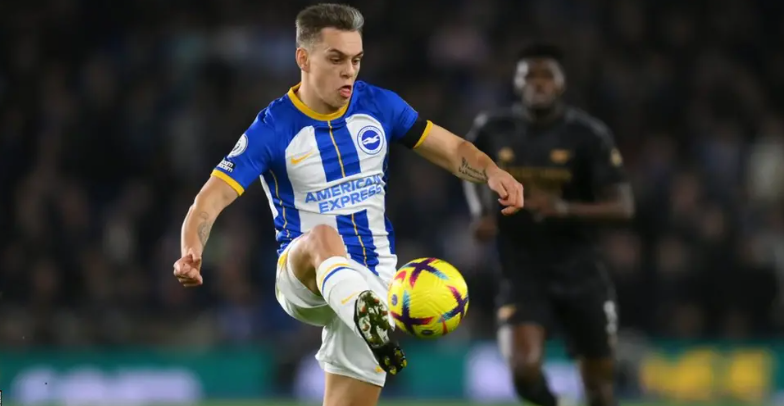
Leandro Trossard, a Belgian forward, joined Brighton from Genk, Belgium, in the 2019/20 season after four loan spells. He became a key player for the club, especially during the 2022/23 season where his significant contributions helped Brighton achieve a sixth-place finish in the Premier League and qualify for the UEFA Europa League. However, Trossard left for Arsenal the following season, missing the opportunity to play in the European championship with Brighton. During his time at Brighton, he played over 100 games and scored 25 goals.
Memorable Matches and Historic Achievements
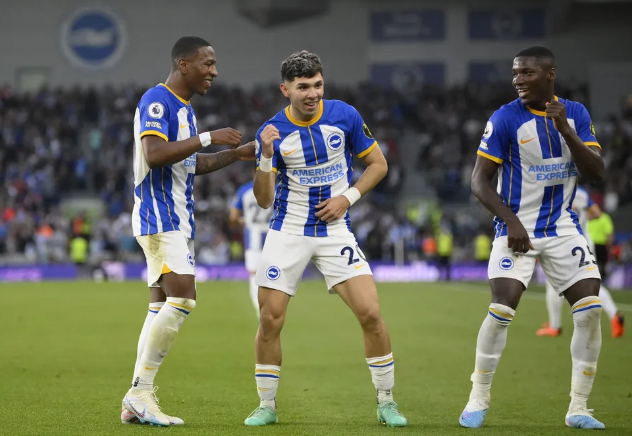
Over the years, Brighton & Hove Albion has been part of games that built their history and legacy, from survival battles to giant victories.
Come with me to discover the biggest moments of this club in its entire history!
1983 FA Cup Final
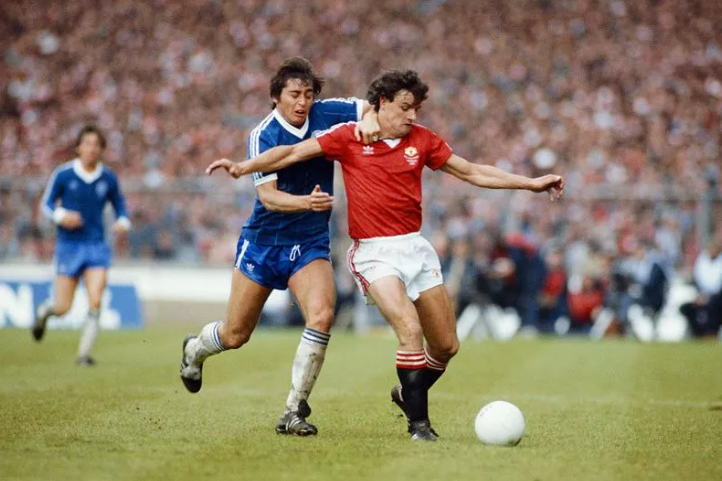
Brighton’s journey to the 1983 FA Cup final remains one of the club’s most significant moments. The Seagulls faced Manchester United at Wembley and held the Red Devils to a 2-2 draw in the first match.
However, the replay, which took place five days later, resulted in a 4-0 defeat for Brighton. Despite this loss, the season demonstrated that Brighton had the ability to compete against England’s top teams and make its mark on history.
1997: Battle for Survival vs. Hereford United
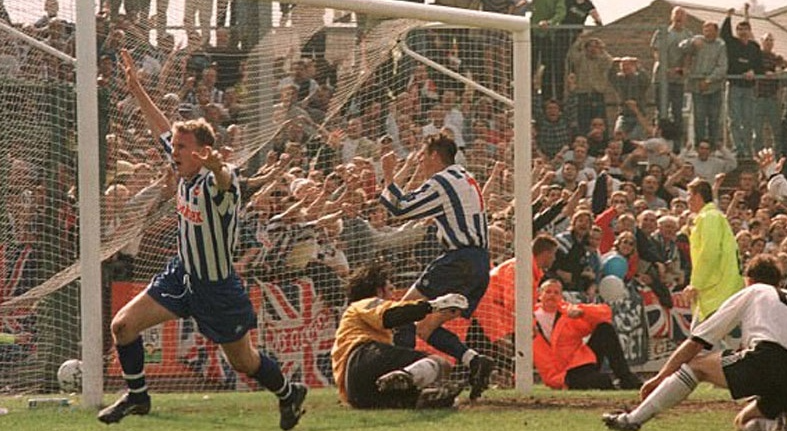
No doubt that this game was one of the most dramatic moments in Brighton’s history. The club faced Hereford United in the final game of the 1996/97 season. Brighton needed at least a draw against Hereford United to be able to play in some football division in England.
And that is what happened. With a goal from Robbie Reinelt, the player equalized the game 1-1, saving Brighton from relegation. Thanks to this goal, the club continued to play in this division; otherwise, it could even have been extinguished.
Rise to the Premier League: 2017 Promotion
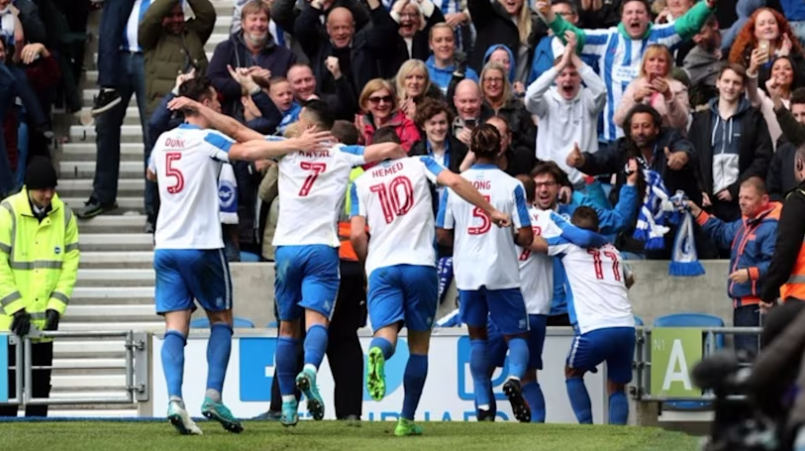
In a historic 2-1 victory against Wigan Athletic on April 17, 2017, Brighton secured their first-ever promotion to the Premier League. Glenn Murray and Solly March scored the decisive goals for Brighton, while Nick Powell’s late goal for Wigan was not enough to change the outcome.
The stadium erupted in celebration as the club reached the top flight of English football for the first time in 34 years. Brighton’s promotion marked a significant milestone in the club’s history, and their continued success suggests that they are unlikely to return to the second division anytime soon.
Making History in Europe
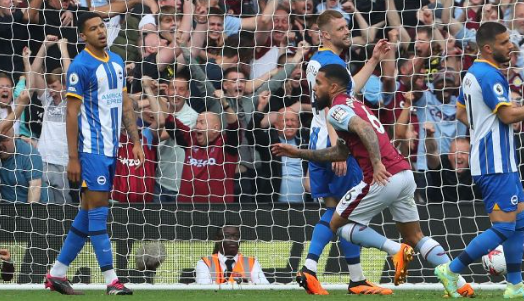
Brighton made history in the 2022/23 season by qualifying for the UEFA Europa League for the first time. Despite a 2-1 loss to Aston Villa on May 28, 2023, with Aston Villa’s Douglas Luiz and Ollie Watkins scoring against Brighton’s Denis Undav, other results in the final round of the Premier League season secured Brighton’s sixth-place finish and a spot in the Europa League.
Future of Brighton
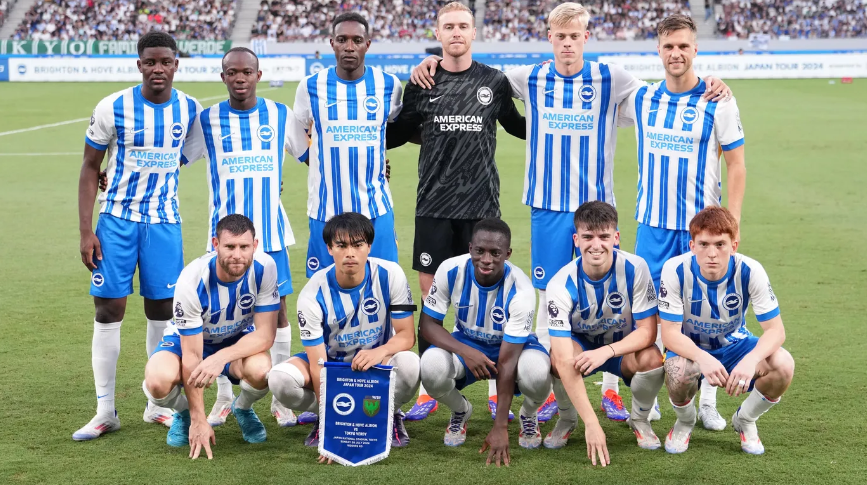
These games, achievements, and players that I showed you are more than just statistics—they are memories that have become part of history. Each moment reflects the passion and hope of the Seagulls and their loyal fans and supporters.
The club started from humble beginnings, as Brighton Hove United, and evolved into a competitive team on the biggest stages of England and European football.
I believe that soon the club will achieve even greater success, reach more championship finals, qualify for the UEFA Champions League and maybe one day, win it.
For Brighton & Hove Albion fans, the best chapters of this history are still being written.
Write Your Own History with FootballTeam

We showed some of the most beautiful moments in Brighton’s history, and now it’s time for you to dominate the football pitch in the virtual world and write your beautiful history. FootballTeam is the next-level experience you’ve ever wanted, taking your competitive spirit one step further against people from all over the world.
Join over 1 million registered players in a series of different competitions, each one with its own set of rules. Test your abilities as both a player and manager, allowing you to do everything you want and create the dream team to achieve everyone’s dream: becoming the #1 player in the world.
You can also invite your friends and enjoy this experience together to see who’s the best among you. The game allows you to connect with people from all over the world through a series of devices, whether desktop or mobile, right from your browser, dismissing the need for downloads.
Customize your own character and prepare to dominate the sports scene in this incredible experience. Visit the main page and register now to start enjoying the experience for free!